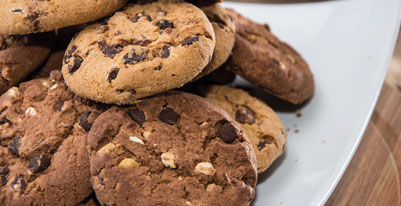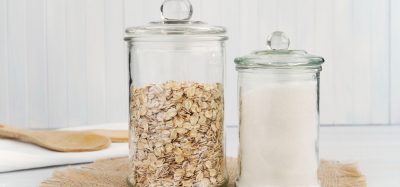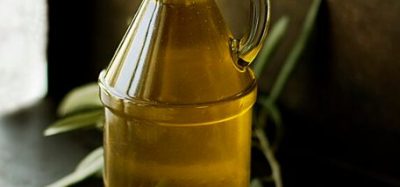A novel approach to reducing the total and saturated fat content of baked goods
- Like
- Digg
- Del
- Tumblr
- VKontakte
- Buffer
- Love This
- Odnoklassniki
- Meneame
- Blogger
- Amazon
- Yahoo Mail
- Gmail
- AOL
- Newsvine
- HackerNews
- Evernote
- MySpace
- Mail.ru
- Viadeo
- Line
- Comments
- Yummly
- SMS
- Viber
- Telegram
- Subscribe
- Skype
- Facebook Messenger
- Kakao
- LiveJournal
- Yammer
- Edgar
- Fintel
- Mix
- Instapaper
- Copy Link
Posted: 5 March 2014 | Charles Speirs, Bakery Science Manager, Campden BRI | No comments yet
In 2008, the Food and Agricultural Organisation and the World Health Organisation reviewed their recommendations on dietary fat and fatty acids in view of the growing evidence on dietary fatty acids and health outcomes1. The key recommendation was that our diet type should change to limit the saturated fatty acid content to 10 per cent of the dietary energy intake. The saturated fatty acids should be replaced with polyunsaturated fatty acids. By adjusting the ratio of saturated to unsaturated fatty acids in the diet, the level of low density lipoprotein cholesterol in blood serum is reduced, which correlates with a decrease in the risk of coronary heart disease.


A novel approach to reducing the total and saturated fat content of baked goods (Copyright HandmadePictures / Shutterstock.com)
Fat, in either saturated or unsaturated form, is the most calorie dense nutrient available to us. The public health responsibility deal, which the UK Food Industry has signed up for, was put in place following the Call to Action on Obesity in England2, which set out the importance of action on obesity, and issued a challenge to the population to reduce its total calorie consumption by five million calories (kcal) a day. One route to do this is to reduce total fat content. Additionally, the public health responsibility deal saturated fat reduction pledge3 recognises the need to reduce saturated fat consumption to less than 11 per cent of food energy compared to current levels of 12.7 per cent.
Subsequently, there are drivers to reduce the total fat and also the saturated fat content of our diet. Bakery products such as cakes and biscuits contain significant amounts of fat. For example, the short dough biscuit recipe used in this study has a total fat content of about 22 per cent, 41 per cent of which is saturated fat, and the standard yellow or high ratio cake recipe has a total fat content of about 16 per cent, 35 per cent of which is saturated fat.
Fat has a range of technical roles in both cake and biscuit manufacture and any fat reduction or replacement with an alternative material must ensure that these roles are still met.
The key role of fat in biscuit dough has been described as shortening4 , which gives biscuits their characteristic ‘melt in the mouth’ crumbly texture. The mechanism by which fat contributes this property to biscuits is by coating flour particles during the mixing of biscuit dough. This fat coating prevents gluten from absorbing water during mixing and becoming elastic and extensible5. Gluten development is essential in bread dough but is to be avoided in biscuit dough; otherwise the biscuits produced can be undesirably tough and chewy.
A secondary role of fat is to coat any air bubbles present in order to enhance their stability during baking. This role is similar to the stabilising effects of fats on bubbles in bread dough and cake batter6,7 and prevents the bubbles rupturing and coalescing into larger bubbles.
While both liquid and solid fat can be used to coat wheat particles to restrict gluten development, the firmness, and therefore the machine-ability of dough, is directly related to the solid fat index (SFI) of the dough fat8. Dough which contains liquid oil at the point of handling is difficult to work and develop9. The ability to coat bubbles to retain integrity during dough handling and baking is also best found in a fat with a developed crystalline structure rather than in a liquid oil10. Hard fats, rather than oils, are used to provide the required functionality in biscuit dough, with the naturally produced ingredients of choice being either palm oil, which has a melting point of around 36°C, or butter, which melts in the temperature range 32 – 35°C.
The use of saturated fats is therefore central to biscuit technology but also has a major role in cakes. By interfering with gluten development, fat contributes to a shorter texture with a softer eating crumb. Fat also acts to improve the shelf life of cakes since it acts as a moisture barrier, preventing significant increases or decreases in moisture content over typical storage conditions. Fat provides intrinsic flavour and lubricates the bolus of cake and biscuit during chewing and swallowing. Fat is also a reservoir for fat-soluble flavour components generated during baking.
Replacement or reduction of fat in both biscuit and cake therefore requires any alternative material to perform a range of technical functions associated with the development of structure and texture together with eating quality considerations. Having reviewed the literature on fat reduction, it was decided to pursue an approach based on modified water-in-oil emulsions.
The approach adapted was based on the teaching of patent WO 93/1961311, which relates to the use of a gelling system to replace water in margarine or reduced fat spreads. A liquid system containing all the necessary elements to form a thermally stable gel is prepared. The liquid system is then emulsified in oil to produce a water-in-oil emulsion. The liquid-to-solid transition is triggered once the emulsion is formed to give a gelled aqueous phase. The gelled aqueous phase is thermally irreversible, which means that the aqueous phase of the margarine or reduced fat spread produced has rheological properties which are largely independent of temperature. In practice, the liquid system can be a sequestered sodium alginate or sodium pectate solution containing a dispersed sparingly soluble calcium salt. Alginate and pectate form gels in the presence of calcium. The level and type of sequestrant can be used to control the rate of release of calcium such that gelation happens after the emulsion is formed. This is shown schematically in Figure 1.
Figure 2 shows examples of control and test biscuits where the reduced fat biscuits had 50 per cent of the shortening replaced by a 50:50 alginate gel-in-oil emulsion prepared using this technology. The corresponding dimensional measurements, hardness values and moisture contents are shown in Table 1.
The reduced fat biscuits had lower moisture contents than the control and were shorter in length than the control biscuits. The stack height and the width of the sets of biscuits were similar. The control biscuits were harder than the reduced fat biscuits; however, this difference was not significant.
The control biscuits had a total fat content of 21.6 per cent and a saturated fat content of 10 per cent. The test biscuits showed a decrease of 21 per cent in total fat and a significant decrease of 41 per cent in saturated fat compared to the control, enabling a claim of ‘a reduction in saturated fat content’ or ‘reduced saturated fat’ to be made.
This approach was also evaluated in high ratio cakes. Figure 3 shows examples of control (full fat) cakes compared to cakes where 50 per cent and 25 per cent of the fat has been substituted with a 50:50 alginate gel-in-oil emulsion.
It can be seen that the appearance and volume of test and control cakes are similar.
Water activity (ERH) and moisture content were measured over 21 days. The ERH values are shown in Figure 4 with the corresponding moisture contents shown in Figure 5.
It can be seen that both moisture content and ERH of cakes decreased over storage. There is some evidence to suggest that the ERH of cakes made with the alginate gel was lower than comparable control cakes, despite having higher moisture contents. This suggested that the encapsulated water added through the alginate gel was less mobile than the water added to the conventional recipe. This means that a moist eating cake with a reduced fat content can be made with no reduction of mould-free shelf life. The fat composition of the cakes is shown in Table 2.
Figures in brackets are negative values showing a fat reduction. The cake containing alginate gel-in-oil emulsion with a 50 per cent shortening reduction has a saturated fat reduction of 32.8 per cent, again enabling a claim of ‘a reduction in saturated fat content’ or ‘reduced saturated fat’ to be made.
In conclusion, the use of alginate gel-in-oil emulsions offers food manufacturers a means of achieving total fat reduction and also significant saturated fat reduction in both short dough biscuits and high ratio cakes with no compromise on product quality. This novel approach to reformulation can help manufacturers work towards the targets of the public health responsibility deal, and the saturated fat reduction pledge in particular.
References
- Schenker, S. (2012) ‘UK recommendations for dietary fat: should they be reassessed in light of the recent joint FAO/WHO recommendations?’ Nutrition Bulletin. 37 (1), 37-46
- Department of Health UK (2011) ‘Healthy Lives, Healthy People: A call to Action on Obesity in England’. UK Government. Accessed through responsibilitydeal.dh.gov.uk
- Department of Health UK. (2013) ‘Saturated Fat Reduction Pledge’. UK Government. UK Government. Accessed through responsibilitydeal.dh.gov.uk
- Atkinson, G. (2011) ‘Fats and oils as biscuit ingredients’. In: Manley, D. (eds.) Manley’s technology of biscuits, crackers and cookies. Fourth Edition. Woodhead Publishing Limited, pp.160-180
- Lawson, R., Millar, A.R., and Thacker, D. (1981) ‘Rotary moulded short dough biscuits: Part II. The effects of the level of ingredients on the properties of Lincoln biscuits’. Flour Milling and Baking Research Association. Report number: 93
- Brooker, B. E. (1993) ‘The stabilisation of air in foods containing fat – a review’. Food Structure 12 (1), 115-122
- Brooker, B. E. (1996) ‘The role of fat in the stabilization of gas cells in bread dough’. Journal of Cereal Science. 24 (3), 187-198
- Sai Manohar, R. and Haridas Rao, P. (1999) ‘Effect of emulsifiers, fat level and type on the rheological characteristics of biscuit dough and quality of biscuits’. Journal of the Science of Food and Agriculture. 79 (10), 1223-1231
- Atkinson, G. (2011) Saturated fat reduction in biscuits. In: Talbot, G. (eds.) Reducing saturated fats in foods. Woodhead Publishing Limited, pp.283-300
- Sahi, S., Gates, F., and Maher, N. (2013) ‘Determination of bulk and interfacial properties of wheat flour/water systems’. Campden BRI report number: 339
- Izzo, M.T., Jerome, R.A., Nace, J.A., and Speirs, C.I. (1993) ‘Gelling system as a fat substitute’, Patent WO 93/19613. Mars Inc
About the author
Charles Speirs graduated from The University of Strathclyde with First Class Honours in Food Science and also has a PhD in the field of food ingredients from The University of Nottingham. In his roles as Baking Science Manager at Campden BRI, Charles manages a bakery-focused research programme, organises technical training programmes, conferences and seminars, and translates clients’ needs into confidential contract research projects.






